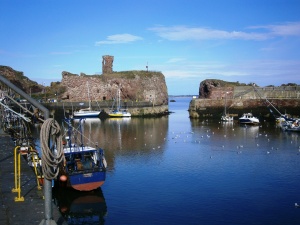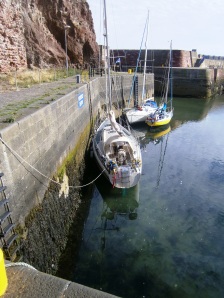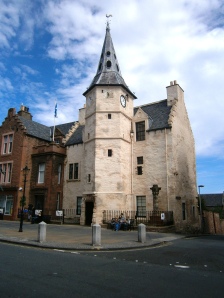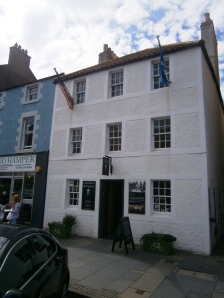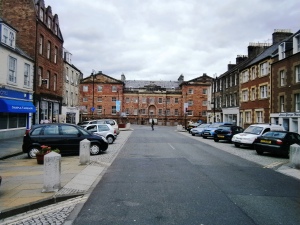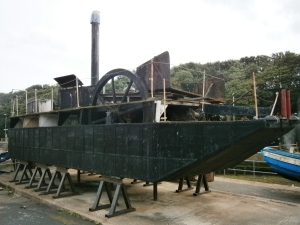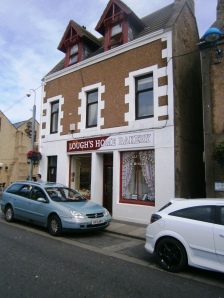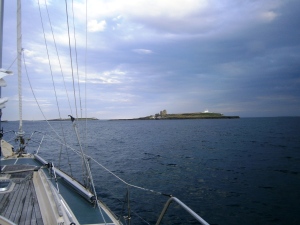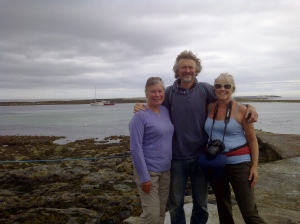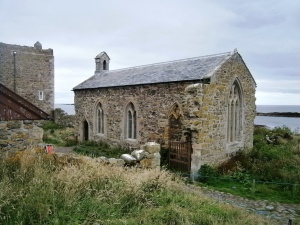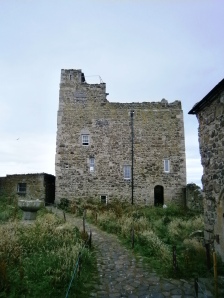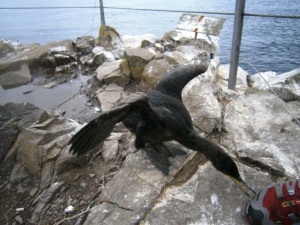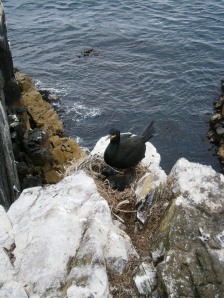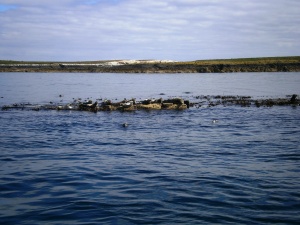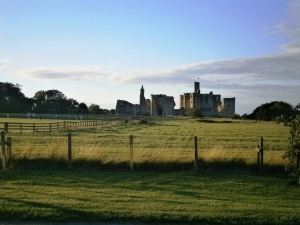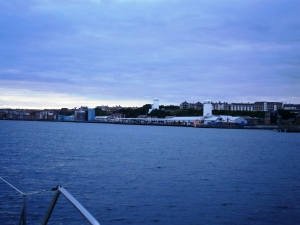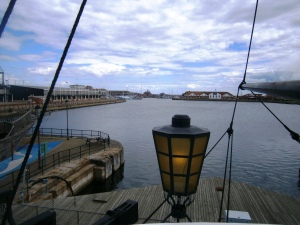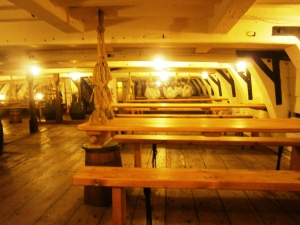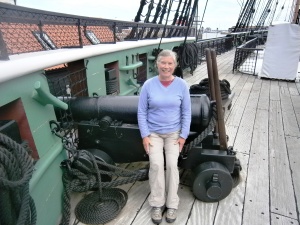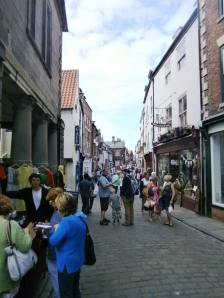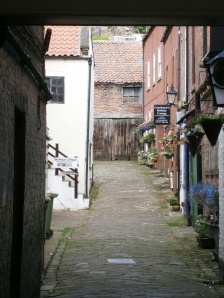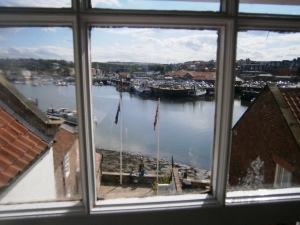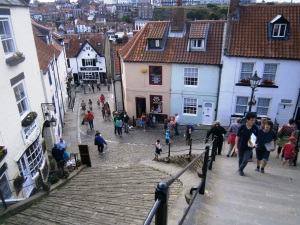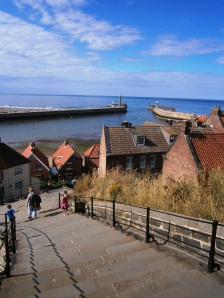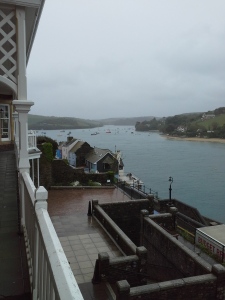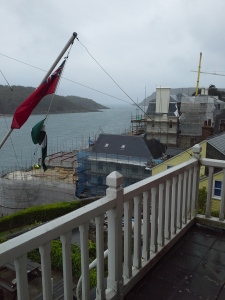Wednesday 21st August – Lowestoft to Southwold

Up the pole again…This time it was John’s turn to go up the mast at Lowestoft to fix the top of the roller reefing on the foresail.
We are in Hamilton Dock at Lowestoft where the marina that has been formed in part of the old fish dock is an unmanned off-shoot of the main establishment up river towards Oulton Broad. Everything is done remotely including collecting the dues. (Lowestoft is one of two places where the Norfolk Broads system joins the sea via Oulton Broad, Great Yarmouth being the other). Before leaving we need to fix the top of the furling gear. Geoff from the boat next to us kindly offers to winch John up and the job is duly done. Happily the other half of the offending collar is still up there so it appears that all is well.
We set off around 1130 for Southwold which is around 15 miles south and which once again has a tidal window to enter the harbour on the River Blythe. We have checked the time we can get in with the harbour master there as we find that it pays to use local knowledge rather than rely on the almanac. Once again the wind is on the nose so after trying to beat down the coast we end up motor sailing in order not to be late. However, it is sunny and we have a nice view of the Southwold waterfront as we pass by.

The River Blythe at Southwold. Strong tidal flows due to the tides filling and emptying the inland lakes and salt marshes make boat handling tricky. The river originally reached the sea further south but a great storm in medieval times changed its course so it now reaches the coast between Waberswick and Southwold.
There is a big swell running into the harbour entrance, which is narrow and between two lines of wooden piles. An Environmental Survey boat races in ahead of us, which is useful as we can see how it is tossed about at the entrance and which route to take. There is a big tidal flow coming out of the River Blythe so we have to motor hard to get in but in due course we reach the moorings along the river and are instructed to raft up against a bigger boat by the harbour master. There is such a strong tidal flow that it takes quite an effort with help from the harbour master to tie up but all is done.

The low lying land around the River Blythe at Southwold is prone to flooding so flood defences are a real need. This wall is a recent addition round the back of the houses and the Harbour Pub that front onto the river – presumably the buildings might get flooded but not the low lying land behind them?
We moor outside the Harbour Pub so we award ourselves a late pub lunch, sitting outside in the warm sun. At last, the summer we have been missing! The smoked fish and beer is excellent, both products of Southwold.
Lunch having been taken, we set off across the field and marshes to shop at Southwold which is about a mile away from its river. It is almost biblical, walking across the mown fields and crossing the little streams lined with bull rushes. The view has probably not changed for a century or two.

Southwold has not changed much over the past century or more. This is the Swan Hotel which overlooks the centre of the town. There have apparently been butchers in the row of shops opposite for more than a century.
Southwold is a Suffolk gem. It probably has not changed much since Victorian times. It is well known for its colourful beach huts and idiosyncratic pier. However, we stop at the town centre to stock up on food and to have a little look round the picturesque town centre. Southwold is also known as the home of Adnams beer. Shopping done, John takes a quick detour to photograph the lighthouse (which is in the middle of town), the brewery and some of the houses before rejoining Yvonne for an excellent locally made ice cream.
We sit on the green eating the ice cream and watching the holiday makers and families. The grass of the green is rather brown so they cannot have had much rain here.
Back at the boat, the tide has gone out and we are just touching the bottom. The pub is still busy and along the quayside the various fishmongers are doing a good trade out of their wooden shops. We suspect Southwold is having a good season.

Part of the Adnams brewery at Southwold. Some of the brewery manufacturing space is located in former houses with the facade being kept to preserve the street character. Adnams do not miss a trick with their location in a tourist centre, offering brewery tours and even having their own gin distillery.

One oddity of Southwold is the light house located in the town centre rather than the sea front. However, we can testify that is is clearly visible from the sea! The Sole Bay Inn is the Adnams pub that backs onto their brewery
Ship’s log
Day’s run: 17.3 nm
Total miles to date: 2083.3 nm
Engine hours: 2.5 hours
Total engine hours: 254.0 hours
Hours sailed: 3.0 Hours
Total hours sailed; 454.0 hours
Thursday 22nd August – Southwold to the River Deben
The harbour master confirms that there will be sufficient depth to leave over the sand bar at the harbour entrance by 0900 so we water up and get ready to depart. The current in the river is already flooding in very fast so we enlist the help of our neighbours on the adjacent boat to help us off. Sundart swings round with the stream to face out of the harbour as the warps are released but all is well and we depart without further ado. Our friends Julie and Paul Ashley have kindly offered the free use of their mooring in the River Deben so we plan to stop there for a couple of days to meet up with family and friends and relax as we sailed quite a few miles since our last stop at. Grimsby.

Southwold has a long tradition of catching and selling its own fish from its harbour. The buildings are all traditional creosoted wooden sheds, which are generally well maintained and which fit in well with the surroundings.
The exit from the harbour is much less exciting than our entry and we are soon pointing south. We try to sail down the misty coast but the wind is very light and from the south so once again we end up motor sailing.

Sizewell nuclear power stations – quietly getting on with the job of generating electricity day in and day out whilst the politicians and civil servants fumble around with our energy policy. The dismantling of our ability to engineer our own nuclear power stations is one of the great political strategic failures of the last decades.
We pass the nuclear power stations at Sizewell as they quietly get on with providing electricity.
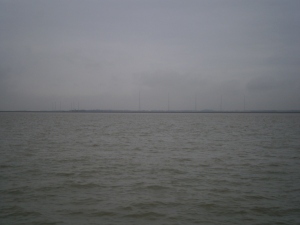
The radio masts in the mists on Orford Ness that transmit the BBC World Service – a wonderful institution that anyone who has lived abroad learns to appreciate for its unbiased and accurate news
Further south we pass the Georgian town of Aldeburgh and then Orford Ness with its red and white light house (now sadly decommissioned). We see the array of aerials from which the BBC World Service is transmitted which stand in a large circle on the Ness. Orford Ness is a very long spit of shingle and sand that has built up over the centuries, diverting the River Ore so that is now runs about 10 miles south, just yards from the sea in places and depriving the old town of Orford of its seashore in the process.

The “Pagodas” on Orford Ness – once used for testing of munitions. The buildings were designed to absorb the blasts and collapse in a controlled fashion if the experiments went wrong.
South of the lighthouse we pass the strange buildings known as pagodas that were part of the installations used to test munitions over a long period including the detonators for atomic bombs. There is no longer any military activity here and the public are allowed on to Orford Ness with limited access as there is still some unexploded ordnance around.
Just south of Orford is the island of Havengate, one of the first Nature Reserves for Birds to be set up and where the first colony of avocets in the UK established itself. (The avocet with its long upward curved beak is the emblem of the RSPB).

The entrance to the Deben is guarded by a Martello Tower, one of many from here southwards which were built in the Napoleonic Wars
The entrance to the River Deben has a reputation for being rather awkward as the sand and shingle banks at the entrance move around (so the buoyage has to be altered regularly) and there is a strong tidal flow in or out of the river. We phone George Collins, the venerable and ever helpful voluntary harbour master at Ramsholt where the mooring is on the Deben. George confirms the current buoyage and also that he has reserved a mooring right opposite the pub and jetty as requested by Paul Ashley – fantastic!
We find the fairway buoy without difficulty outside the Deben entrance and follow the buoyage into the river without problem and have caught the tides right so there is still a little bit of flood into the river. George has been as good as his word and we are soon moored up in a really lovely location – classic Suffolk river just as Constable would have painted it.

George Collins. For over 50 years he and his father have been the harbour masters at Ramsholt. The old red boat that serves as his office still floats on a spring tide.

Julie and Paul Ashley who kindly sorted out a mooring for us on the Deben and took us out for a meal.
We go ashore in the rubber dinghy to meet up with Julie and Paul who arrive at 5 pm to take us out to supper. We are introduced to George, who is well into his eighties. George lends us his trolley for our dinghy. George and his father before him have been harbour masters here for over fifty years, which must be a record. George does it voluntarily and very kindly donates the tip Paul would have given him for his services to our charity.
The Ramsholt Inn is closed tonight as they are hosting as charity do so we head off towards Woodbridge for a very pleasant meal and catch up with Paul and Julie as we haven’t seen them for quite a few years. They kindly treat us to supper. Paul now works at the huge container port at Felixstowe and has to be up early the following morning so we are delivered back to Ramsholt by 10. There is a moon over the meadows, rounding off an excellent evening.
Ship’s log
Day’s run: 22.9 nm
Total miles to date: 2106.2 nm
Engine hours: 4.0 hours
Total engine: 256.0 hours
Hours sailed: 5.0 Hours
Total hours sailed: 459.0 hours
Friday 23rd August – A day at Ramsholt by the River Deben
What a beautiful day and place with lots of bird song from the banks and river! We have arranged to meet our friends Linda and Mike for lunch at the pub and later will re-visit that establishment with John’s youngest sister Jo and her family and the Hen. The pub is duly booked, and then John catches up with some work whilst Yvonne sorts out the boat.

Samphire – common along the shores of salt marshes and tidal rivers but not many people know how good it is to eat.

The lovely old church of All Saints at Ramsholt. A classic Suffolk church built of flint and stone with a round tower that probably dates from Norman times. The churchyard has mown pathways but is otherwise kept as a nature reserve.
We decide to go ashore early for a walk up to the little church on the hill with its old round flint tower. The walk is along the river bank then up through some meadows It proves to be a fine old church that is clearly still very much in use and cared for. We buy a local history of the area.

All Saints Church is clearly much loved with fresh flowers and a new seat outside to admire the view.
We pass a pleasant couple of hours with Linda and Mike, enjoying a beer and sandwich outside in the sun with their dogs.
Back on the boat John tries to remove the anchor winch motor, which has seized up, but without success – he sprays it with WD 40 and will have to return to battle with it another day.

Our trip round the UK has given us the opportunity to catch up with family and friends round the country.We enjoyed a family meal at the Ramsholt Arms with the Legoods and “the Hen”

John’s youngest sister Jo and her family (Bob, Hannah and Emily) braved the rubber dinghy to visit Sundart at the moorings on the Deben.
We meet up with John’s family – sister Jo and husband Bob plus daughters Hannah and Emily and the Hen. Jo has driven them all down here after a long day at her job at the N & N Hospital at Norwich. The Legoods trust themselves to being ferried across the river and back on the “rubber flubber” to visit Sundart before retiring to the Ramsholt Arms for an excellent meal. Hannah has passed her teaching degree with flying colours and has her first teaching job and Emily has good GCSE results so it is celebration time.
By 10 pm we are saying our goodbyes as they have an hour and a half drive to get back home.
It has been a good day in a lovely spot at the River Deben
Saturday 24th August – River Deben to the Walton Backwaters.
The forecast was for a murky, rainy day so we are not surprised to wake to a very misty morning with low clouds. However, it makes for an atmospheric picture of the river.
Paul Ashley has recommended the Walton Backwaters to us which is where we are bound today but as we need to wait for the tides Yvonne cooks up a bean chilli for super whilst John seeks and finds the little leak in the rubber dinghy that we suspected last night, bit it is too wet to fix it today.
At 11 am we thank George again for his help and donation and set off down the river, sailing against the tide. At the entrance we boost the power with the engine to get over the flood coming in and reach the sea. The wind has helpfully gone round to the north so at last the wind and tide are all pointing in the right direction. We set the spinnaker and broad reach down the coast. We need to cross the busy shipping lane into Felixstowe container port but there is a succession of very large ships passing in and out with their attendant pilot boats and tugs so we drop the spinnaker by the shipping lane to wait for a gap then quickly motor across. The Port of Harwich issue a useful booklet which details the recommended crossing points along with lots of other useful information.
The shipping lane past we set the full sails and continue down with a light wind to find the fairway buoy that marks the entrance to the long way in over the shallows into the Backwaters. We are getting used to having very little water under the keel for many East Coast Rivers and passages which is commonplace for east coast sailors but a novelty for us coming from the south west cruising grounds.The Walton Backwaters are a large area of meandering waterways, salt marshes and low lying islands behind Walton-on-the-Naze. It was immortalised as the Secret Water in the book of that name by Arthur Ransom in his Swallows ands Amazon series of books. However, today the skies are threatening, the views are very misty and the forecast is for a lot of rain (it is Bank Holiday Saturday after all). As we enter the narrow Walton Channel there is a jumble of boats anchored and moored so we abandon our plans to anchor and decide to do a marina night to shower, fill up with stores, water, gas and diesel and go for anchorages in the better weather later this week. Titchmarsh Marina finds us a slot and we moor up as the heavens open. However, the Marina provides a friendly welcome, sorts out our gas shortage and we are soon settled in there.
Sundart has been co-owned by the same syndicate for 29 years – which must be a record. However, three of the five shareholders have decided to hang up their sailing boots. We have had a debate with the remaining co-owners about keeping Sundart but they have concluded that the boat does not really suit their future needs. We have also decided that much as we like Sundart it is really a bit too big for us to keep on our own so reluctantly the boat will have to be sold. It is a very sad decision as we have had a wonderful twelve years with the boat and syndicate, not least this summer Round UK trip. We visit the local broker at Titchmarsh to get some basic information on the process if the boat is sold through that route.
We retire back to the boat for the evening as the rain cascades down outside: not the best of days.
Ship’s log
Day’s run: 12.5 nm
Total miles to date: 2118.7 nm
Engine hours: 1.3 hours
Total engine hours: 257.3 hours
Hours sailed: 4.0 Hours
Total hours sailed; 461.0 hours
Sunday 25th August – Walton Backwaters to the River Orwell.

Felixstowe – one of the busiest ports in the country, operating on a 24/7/364 basis. Much comes in, some goes out.

A distant view of Harwich from across the River Orwell at Felixstowe. Harwich’s long maritime history dates from around 1340 when Edward III’s fleet assembled there before sailing to defeat the French at the battle of Sluys. Harwich remains an important port, being the departure point for ferries to Scandinavia. Lightships used to be serviced here too and several are still moored in the Rivers Orwell and Stour, both of which enter the North Sea here.
We awake to a sunny morning with a light breeze. We have been recommended to visit the River Orwell by the marina manager so we decide to go there today, even though it is back north. We need to stock up on vittles so set out to walk to the shops. The Marina assures us it is “only half an hour’s walk” (we have heard that before). It soon becomes clear that it is a lot further than that. Yvonne has a sore knee so decides to turn back. By good chance a couple driving by us in the lane stop to offer John a lift to the shops: they are boat owners on their way to stock up who have had the experience of walking this route in the past. They are a godsend, ferrying John back to the boat laden with shopping. Our faith in Essex people is restored!
Stores stowed, water and diesel filled up we set off back out of the Backwaters. This is clearly a popular spot: the sunshine has bought out even more boats which are flooding into the area. Perhaps we will get the opportunity to explore this area at a quieter time in the future. We motor against the wind for a few miles before we can set the genoa and sail for the Orwell in the stiff northerly breeze. It is a lovely day for a sail. We pass the massive Felixstowe container terminal, with several ships being loaded and discharged. On the opposite shore is Harwich, older and with its own port (originally called Parkestone Quay after the Director of the Great Eastern Railway who built the modern port and rail link) which caters for ferries across the North Sea. It is a busy corner as the River Stour also runs into the sea at the same point.

The Orwell is home to many craft including Thames barges. It runs through woods, fields and marshes and has long been a beauty spot. Despite the volume of leisure and some commercial traffic it retains its calm and attraction.
Once past Felixstowe the River Orwell turns out to be delightful with tree lined banks interspersed with fields reaching down to the river. The river banks are flanked by rushes and mud flats. This is a popular boating river as well as carrying commercial traffic up to Ipswich about 12 miles upstream. There are several marinas and many moorings along some stretches but the river is big enough for there to be a general feeling of tranquility
We sail on for about five miles to just below Pin Mill (made famous by various artists and a renown boating centre) where we anchor. It is a peaceful spot with curlews, cormorants and oyster catchers. There are lots of boats sailing up and down the river including the occasional Thames Barge but the river is wide enough for everyone.
Anchored up, we read the Sunday paper, watching the world go by. Later, after supper, flocks of curlews fly over with their long, curved beaks making a distinctive sight. There is a glorious sunset. This is truly a delightful river.
Ship’s log
Day’s run: 9.8 nm
Total miles to date: 2128.5 nm
Engine hours: 1.5 hours
Total engine hours: 258.8 hours
Hours sailed: 2.2 Hours
Total hours sailed; 463.2 hours
Monday 26th August – River Orwell to River Blackwater

Pin Mill – made famous in by various artists and a favourite sailors’ haunt. There are numerous house boats, Thames barges and many old boats in various states of decay along the shore.
It is another lovely summer morning with lots of bird song. We up anchor, set the sails and sail a mile up river to have a look at Pin Mill. There are lots of boat houses and several Thames Barges. Sights seen, we turn round and head back to the sea.
Our next port of call will be the River Blackwater, the next estuary south. It is Bank Holiday and we cannot recall seeing so many boats out – we have become used to being the only boat around on much of our travels. However, there is room for all and it is a splendid sailing day.

We caught up with the barge Cambria as it slowly sailed along the River Blackwater off Mersea Island
The wind is northerly force 4 to 5 and the tide is running south so they are all going in our direction and we have one of the best sails of this trip, out of the Orwell and south past Walton-on-the-Naze and Clacton-on-Sea. These are classic seaside resorts with fun fairs, promenades and miles of beaches. We can see the crowds on the beaches.

At anchor off Osea Island in the upper reaches of the River Blackwater. The Edwardian manor was built by a brewer as a retreat for recovered alcoholics!
The navigation is interesting as there are various sand banks which have to be avoided. As we near the Blackwater the wind drops so we set the spinnaker and have a fine sail up the estuary. To the north we can see Mersea Island with the River Colne that leads up to Colchester. West Mersea is busy and we can hear loud music from there. To the south we see Bradwell with its power station and marina. We have not seen many motor boats out on our travels but Essex Man does not disappoint! There are water scooters and power boats of all sizes, all seeming to be run at maximum speed in all different directions.
The spinnaker decides to jam when we try to take it down but Yvonne is able to motor the boat round in big circles whilst John untwists the spinnaker from the forestay and calm returns. We no doubt provided a bit of entertainment for the locals! We anchor off Osea Island and do the British thing of taking tea and cake – crisis? What crisis?!
As the evening draws on the boats all go home and peace descends. It is another lovely spot.
Ship’s log
Day’s run: 28.9 nm
Total miles to date: 2157.4 nm
Engine hours: 0.8 hours
Total engine hours: 259.6 hours
Hours sailed: 7.0 Hours
Total hours sailed; 470.2 hours
Tuesday 27th August – River Blackwater to River Roach

Looking out to sea from Osea island. The traditional boat that has been dried out on the shore as the tide receded was being scrubbed in the traditional way. Although the island is private the shore between high and low tide is crown property and can be accessed by the public.
We awake to bright blue skies and warm sunshine. We breakfast on deck and watch a classic bilge keeled boat being beached and dried out as the tide drops, presumably for scrubbing and anti-fouling.
We set off sailing but the wind is light and gradually falls away so we end up motoring slowly out of the estuary. We are going south again, to the southernmost rivers in Essex – the Crouch and its tributary the Roach. The direct distance is not far but we have to track round the big sandbanks off this coast, which doubles the distance. It is a tedious process with little or no wind. Even the off-shore wind farm turbines are static. However, the sun is warm and we eventually get to the River Crouch. We decide to cut our losses and seek out the anchorage shown on the chart in the River Roach, which feeds into the Crouch near the sea. The anchorage is behind the Island of Foulness, which is where a military firing range is located, firing over the Maplin Sands out at Sea. As we motor in we see a red flag being lowered but think no more of it.

One man and his boat – homeward bound as the evening sun sets over the River Roach which runs through the Essex marshlands – a watery expanse of apparent nothingness but attractive in its own way.
The Roach is part of the maze of islands, marshes and watercourses that exist in these coastal parts of Essex and is surprisingly remote and desolate. It has a certain timeless beauty – it probably hasn’t changed round here for centuries. We have the river to ourselves.
We have supper on deck as the sun drops below the horizon. A lone yacht sails slowly by and a half moon rises over the marshes. In the distance we can hear oyster catchers calling.
Tomorrow we will cross the Thames Estuary to Queenborough to pick up our friend Janet Wragg before sailing up the Thames to London, the last and greatest of the cities we will visit on this trip.
Ship’s log
Day’s run: 31.4 nm
Total miles to date: 2188.8 nm
Engine hours: 5.8 hours
Total engine hours: 265.4 hours
Hours sailed: 6.0 Hours
Total hours sailed; 476.2 hours
A following wind and fair weather to you all.
Yvonne and John












